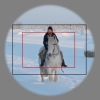Blog
Half-frame or full-frame camera? How to choose? (24.10.2015)
Nikon has been producing optics equipment since 1917 and the first Nikon camera was produced in 1948. Years of technological development and using new innovative solutions has made Nikon the number 1 camera manufacturer. The choice of cameras is quite wide and enough to confuse the ones entering the photography world. That is why we are going to try to clear some of the terms and make the choice easier.
DSLR cameras are mainly produced with two different sized sensors. Full-frame sensor means that the size of the sensor in the camera is the same as the measures of 35mm diagonal film frame (36x25mm). Nikon’s full-frame sensor cameras are marked with abbreviation FX.
These cameras are mostly meant for professionals and advanced photography enthusiasts who are not willing to compromise on anything that might reduce the quality of the photo. Those cameras from Nikon shelf are D4s, Df, D810 and D810A, D750 and D610
The sensor in the half-frame sensor camera is half the size. Nikon’s half-frame sensor’s cut-off factor is 1.5. Those cameras from Nikon shelf today are D3300, D5500, D7200.
A special series of lenses is produced for those cameras and they are marked with DX. These lenses are a lot more compact and lighter and with significant photo quality. The most important difference with FX lens is that the light circle that the lens creates on the surface of the sensor inside the camera is smaller and corresponds to the measures of half-frame sensor. There is a misunderstanding that DX lens cannot be in front of the full frame camera. It can be. Full-frame sensor camera recognizes this lens and in order not to leave the corners of the sensor without image, the camera automatically makes a “cut” itself that corresponds to the measures of DX camera sensor. But nevertheless, using a full-frame sensor camera with DX lens decreases the number photo points due to the cut and that is why, DX lens is not the best choice for FX cameras.
The owners of the half-frame sensor cameras could consider purchasing a lens meant for full-frame. Because then, this lens works perfectly with the camera you have and if you decide to get a full-frame camera in the future, you don't have to sell your lenses together with the former DX camera.
The differences between full- and half-frame sensor cameras are detectable only in nuances and inexperienced viewer might not even make a difference between photos that have been taken by different sized sensors. Nevertheless, the main advantage of the full-frame sensor is its size not the number of pixels. It is possible to put more photosensitive elements to a larger surface and it is also possible to gain a more noise-free image and the drawing ability of the lens is used better. It costs more to have a better quality – full-frame sensor cameras are more expensive and so are the FX lenses.
The sensors of the DX format cameras have become so powerful that when it comes to the technical quality of the image, they compete with full-frame sensors. There is still a significant difference that one needs to know about different lenses and cameras with different sizes of sensors. The differences between the focal length of the camera and field of view angles that appear due to the different measures of the sensors.
Each focal length corresponds to a certain field of view angle. For example, normal lens with a focal length of 50mm is 46 degrees to the field of view angle. This angle is really present on the photo only when the lens is used together with a full-frame sensor (FX) camera. If you use a half-frame sensor camera (DX), then the field of view angle is smaller due to the smaller sensor. Thus, the field of view angle of a 50mm lens starts corresponding to the focal length that is multiplied with the equity beta of 1.5. 50x1.5 = 75mm and within the frame, we see a half-frame sensor field of view which view angle is only 31 degrees.
Both DX and FX lenses have the description of focal lengths on the zoom rings as if the camera had full-frame sensor. The owners of the half-frame have to multiply that with the equity beta of 1.5 to calculate the image angle and consider that the wide angle lens loses it wide angle view due to that. When purchasing telescopic lenses, the owners of the half-frame can feel a lot of joy because the angle of your telescopic lens now corresponds to the one of 1.5 times bigger focal length!
I believe that you now have an overview of FX and DX lenses and cameras. As you can see, there are important advantages to both choices.

